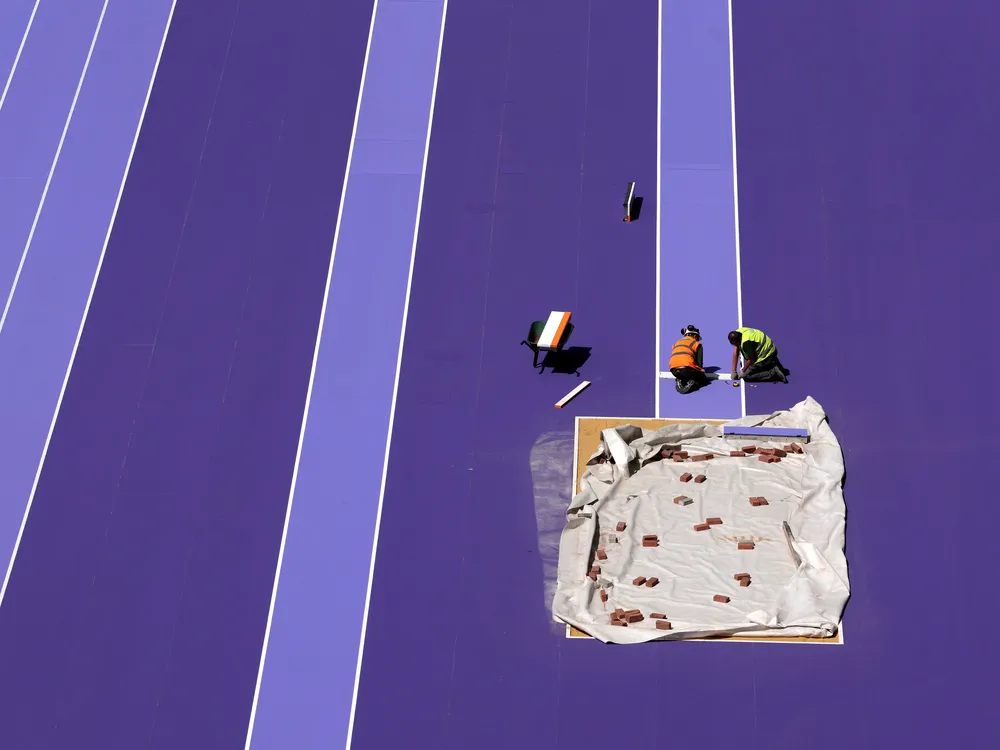Why Is the Paris Olympics Running Track Purple?
The track incorporates recycled mussel and clam shells in a bid to help make the Summer Games the most sustainable yet

Viewers turning in for the track and field events at the Summer Games in Paris next week might just do a double-take: Instead of the usual rust-colored reddish hue, the track is purple.
The new, eye-catching color will serve as the backdrop for runners competing at the Stade de France, the country’s largest stadium, located in the northern Paris suburb of Saint-Denis. The track is made by Mondo, a company based in Alba, Italy, that has made every track used at the Olympics since 1976.
The color was mainly an aesthetic choice, as purple, blue and green make up the palette for the competition venues at this year’s games. The design actually incorporates three separate colors: lavender for the track itself, darker purple for the service areas and gray for the exterior curves at each end.
Even the glue used to adhere the track to its asphalt base—2,800 pots in total—is purple, just in case any becomes visible.
“The big part of the job was to come up with a track that was different from what we had seen … to go a little bit outside the box,” says Alain Blondel, an Olympic decathlete who now serves as the sports manager for the Paris games, to Olympics.com’s Nicolas Kohlhuber.
This is the first time an Olympic track has been purple. But it’s not uncommon for athletics venues around the world to play around with color. For example, since 1986, Boise State University has famously eschewed the traditional green-colored turf for its football field, opting instead for a shocking shade of bright blue.
Color aside, the Paris track is unique for several other reasons. For one, it incorporates the shells of bivalve mollusks, like mussels and clams. Ahead of the games, track-maker Mondo began partnering with a mussel farming and fishing company called Nieddittas to give used shells a second life.
Staff at Nieddittas harvest, clean and prepare the shells—which are made primarily of calcium carbonate—so they can be ground into a powder that can be incorporated into the track material. The shells would have otherwise been headed to a landfill, so the process transforms waste into something useful. It also reduces the need for mining, which is how manufacturers usually obtain calcium carbonate.
All told, 50 percent of the Paris track comes from recycled materials, reports BBC’s Padraig Belton.
This innovative use of recycled natural materials aligns with the goals of the International Olympic Committee, which vowed to make the Summer Games in Paris the most sustainable Olympics yet. Other sustainability efforts include bike parking at many venues, more plant-based food options for spectators, 100 percent locally sourced renewable energy, a geothermal cooling system at the Olympic Village and aquatic center seats made from recycled plastic bottle caps, among many others.
The track’s design and materials may also help athletes perform their best. The Paris track has the same base as the one used at the 2020 Summer Games in Tokyo, with some minor modifications, per reporting by Reuters’ Manuel Ausloos and Vincent Daheron. At those games, athletes set three world records and 12 Olympic records—and officials expect even more records to fall next week in Paris.
“The first indications are that it will be a very, very good track,” Blondel told the Associated Press’ (AP) Jerome Pugmire in April. “If we see athletes with personal bests on the scoreboard, it means we did a good job.”
For this iteration of the track, Mondo researchers improved upon the new polymeric material first introduced in Tokyo. They also used computer algorithms to further refine the optimal shape and size of the air bubbles within the lower layer of the track, which help absorb and then rebound the energy from the runner’s foot striking the ground.
The vulcanized rubber provides good grip and resistance for Paralympic athletes who use wheelchairs and prosthetics. The track has also been specially designed to complement the latest generation of running shoes.
“For the track, we only see the aesthetics, but there is great work that goes into the underlayer,” says Alessandro Piceli, a research and development manager at Mondo, to the Guardian’s Sean Ingle.
Mondo leaders say the Paris track will be 2 percent faster than the one used in Tokyo, per the BBC. But, in 2020, runners also got a boost from hot temperatures and new shoe spike technology, per the Guardian. It remains to be seen how the track will affect athletes’ times, but its creators are confident we will see records fall in Paris.
“The athletes will find this track to be more reactive and better suited for their competition,” said Maurizio Stroppiana, vice president of Mondo’s sport division, to the AP’s Andrew Dampf and Luca Bruno in March.

